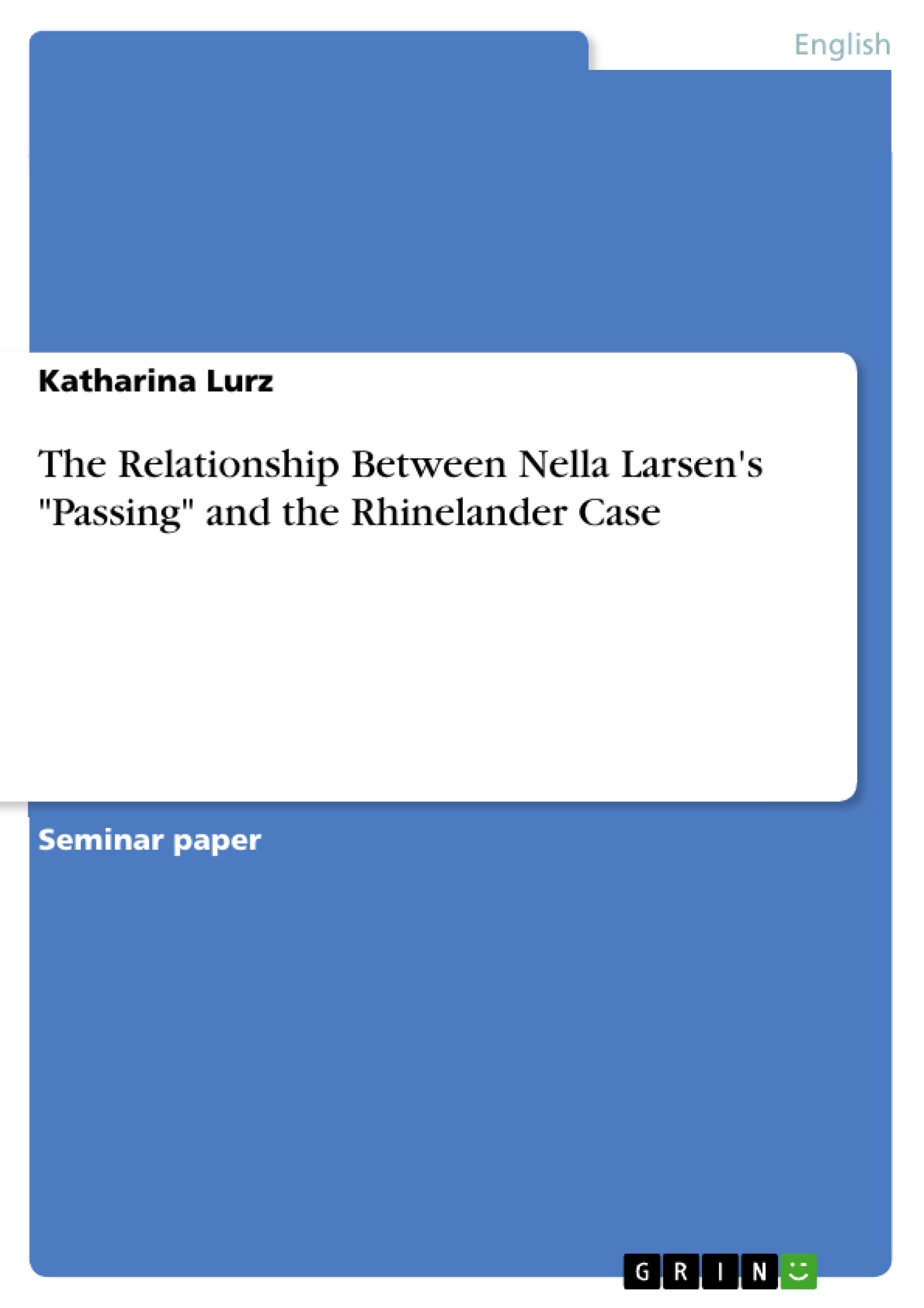Passing by Nella Larsen, published in 1929, features the issue of racial passing in a society which segregates people of Negro descent from the dominant white American class. Wall claims that "Not only is Passing set in Harlem at the height of its vogue, it is itself a product of the vogue. Aptly then, it acknowledges the opportunities as well as the risks that the more fluid racial and cultural boundaries of the period created".
Irene Redfield, one of the two female protagonists, is able to pass, but still chose a life within Harlem and a coloured husband. Her counterpart Clare Kendry, on the contrary, is completely passing by being married to a white man who does not know about her descent. Still, she is highly fascinated by the life Irene leads in Harlem and thus she attempts at leading a double-life. As Clare becomes increasingly involved in the black culture of that time, she also has to fear about her husband finding out the truth about her.
In order to set the issue of racial passing in a historical and cultural framework, I attempt at focusing on the connection between the novel and a jurisdictional case from 1925, called the Rhinelander Case. This case is also being referred to in Passing: "What if Bellew should divorce Clare? Could he? There was the Rhinelander case". Furthermore, Madigan claims the following: "That Larsen has the case enter Irene's mind so quickly, however, testifies to the Rhinelanders' importance to discussions of miscegenation, the law, and racial passing during the period of the Harlem Renaissance". Leonard Kip Rhinelander, who was from the upper white class of New York, got married to Alice Jones, who was mixed-raced and from the working class.
Rhinelander attempted at annulling the marriage as he claimed he had not known about his wife's race before the wedding. She countered by claiming that he has known about their race before their marriage as it was unmistakable. The jury the young couple had to face was all-male and white. Thereupon, this term paper will deal with the following research question: How can the relationship between the Rhinelander Case and Nella Larsen's Passing be defined and which are the means by which this relationship is being constituted?
Table of Contents
- Introduction
- The Act of Passing
- Irene Redfield and Clare Kendry
- Alice Jones
- Representation and Readability
- Representation and Readability in Passing
- Representation and Readability in the Rhinelander Case
- Conclusion
Objectives and Key Themes
The objective of this term paper is to analyze the relationship between Nella Larsen's novel "Passing" and the Rhinelander Case of 1925, a highly publicized trial involving racial passing. The paper examines how the case influenced the novel and how both narratives address themes of race, identity, and social construction.
- Racial Passing: The act of passing as white and the social and psychological implications for those who do so.
- Representation and Readability: How racial identity is perceived and constructed based on visual cues and societal expectations.
- The Rhinelander Case: The legal and social context of the case and its impact on discussions of miscegenation, the law, and racial passing.
- Performance and Visibility: The role of performance in constructing and maintaining racial identity.
- Social and Cultural Norms: The influence of societal norms and expectations on racial passing and the construction of identity.
Chapter Summaries
- Introduction: This chapter introduces the novel "Passing" and the Rhinelander Case, highlighting the central theme of racial passing in a segregated society. It establishes the connection between the novel and the case and outlines the research question: How can the relationship between the Rhinelander Case and "Passing" be defined?
- The Act of Passing: This chapter delves into the concept of racial passing, exploring its motivations, risks, and complexities. It discusses the role of appearance, demeanour, and social discourses in constructing passing identities.
- Irene Redfield and Clare Kendry: This chapter focuses on the two main characters in "Passing" and their distinct approaches to passing. It contrasts Irene's occasional passing for convenience with Clare's complete assimilation into white society and explores the ethical and psychological implications of their choices.
Keywords
The main keywords and focus topics of this term paper include racial passing, representation, readability, miscegenation, Harlem Renaissance, societal norms, identity construction, and the Rhinelander Case.
- Quote paper
- Katharina Lurz (Author), 2015, The Relationship Between Nella Larsen's "Passing" and the Rhinelander Case, Munich, GRIN Verlag, https://www.hausarbeiten.de/document/432063


